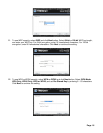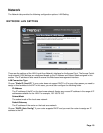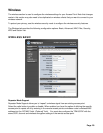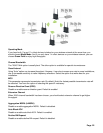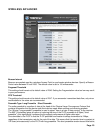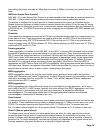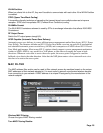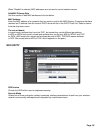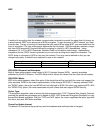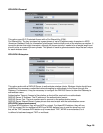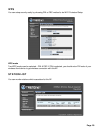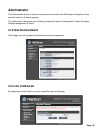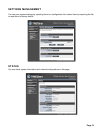Page 24
transmitting the shorter preamble at 1Mbps and the header at 2Mbps, shortening the transmit time to 96
Usec.
IAPP(Inter-Access Point Protocol)
IEEE 802.11F or Inter-Access Point Protocol is a recommendation that describes an optional extension to
IEEE 802.11 that provides wireless access-point communications among multivendor systems.
The protocol is designed for the enforcement of unique association throughout an Extended Service
Setand for secure exchange of station's security context between the current AP and the new AP during
the handoff period. Based on security level, communication session keys between Aps are distributed by
a RADIUS server. The RADIUS server also provides a mapping service between AP’s MAC address and
IP address.
Protection
These protection mechanisms ensure that a STA that is a potential interferer defers any transmission for a
known period of time. These mechanisms are used to ensure that non-ERP STAs do not interfere with
frame exchanges using ERP PPDUs between ERP STAs and that non-HT STAs do not interfere with
frame exchanges using HT PPDUs between HT STAs, thereby allowing non-ERP and/or non-HT STAs to
coexist with ERP and/or HT STAs.
Frame aggregation
Frame aggregation is a feature of the IEEE 802.11e and 802.11n wireless LAN standards that increases
throughput by sending two or more data frames in a single transmission. Every frame transmitted by an
802.11 device has a significant amount of overhead, including radio level headers, media access control
(MAC) frame fields, interframe spacing, and acknowledgment of transmitted frames. At the highest data
rates, this overhead can consume more bandwidth than the payload data frame. To address this issue,
the draft 802.11n standard defines two types of frame aggregation: Mac Service Data Unit (MSDU)
aggregation and MAC Protocol Data Unit (MPDU) aggregation. Both types group several data frames into
one large frame. Because management information needs to be specified only once per frame, the ratio of
payload data to the total volume of data is higher, allowing higher throughput.
MSDU aggregation
MSDU aggregation relies on the fact that most mobile access points and most mobile client protocol
stacks use Ethernet as their "native" frame format. It collects Ethernet frames to be transmitted to a single
destination and wraps them in a single 802.11n frame. This is efficient because Ethernet headers are
much shorter than 802.11 headers.
MPDU aggregation
MPDU aggregation also collects Ethernet frames to be transmitted to a single destination, but it wraps
each frame in an 802.11n MAC header. Normally this is less efficient than MSDU aggregation, but it may
be more efficient in environments with high error rates, because of a mechanism called block
acknowledgement. This mechanism allows each of the aggregated data frames to be individually
acknowledged or retransmitted if affected by an error.
Guard interval
In telecommunications, guard intervals are used to ensure that distinct transmissions do not interfere with
one another. These transmissions may belong to different users (as in TDMA) or to the same user (as in
OFDM). The standard symbol guard interval used in 802.11 OFDM is 0.8μs. To increase data rate,
802.11n added optional support for a 0.4μs guard interval. This provides an 11% increase in data rate.
Short GI (Shorter guard interval)
The shorter guard interval results in a higher packet error rate when the delay spread of the channel
exceed the guard interval and/or if timing synchronization between the transmitter and receiver is not
precise. A scheme could be developed to work out whether a short guard interval would be of benefit a
particular link. To reduce complexity, manufacturers typically only implement a short guard interval as a
final rate adaptation step when the device is running at its highest data rate.



